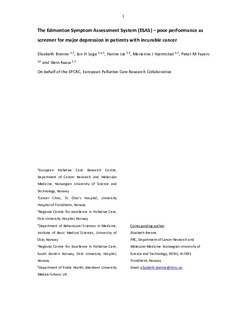| dc.contributor.author | Brenne, Elisabeth | |
| dc.contributor.author | Loge, Jon Håvard | |
| dc.contributor.author | Lie, Hanne Cathrine | |
| dc.contributor.author | Hjermstad, Marianne Jensen | |
| dc.contributor.author | Fayers, Peter | |
| dc.contributor.author | Kaasa, Stein | |
| dc.date.accessioned | 2017-11-20T16:15:04Z | |
| dc.date.available | 2017-11-20T16:15:04Z | |
| dc.date.created | 2016-06-07T14:50:50Z | |
| dc.date.issued | 2016 | |
| dc.identifier.citation | Palliative Medicine : A Multiprofessional Journal. 2016, 30 (6), 587-598. | nb_NO |
| dc.identifier.issn | 0269-2163 | |
| dc.identifier.uri | http://hdl.handle.net/11250/2467217 | |
| dc.description.abstract | Background: Depressive symptoms are prevalent in patients with advanced cancer, sometimes of a severity that fulfil the criteria for a major depressive episode.
Aim: The aim of this study was to investigate how the item on depression in the Edmonton Symptom Assessment System with a 0–10 Numerical Rating Scale performed as a screener for major depressive episode. A possible improved performance by adding the Edmonton Symptom Assessment System-Anxiety item was also examined.
Design: An international cross-sectional study including patients with incurable cancer was conducted. The Edmonton Symptom Assessment System score was compared against major depressive episode as assessed by the Patient Health Questionnaire-9. Screening performance was examined by sensitivity, specificity and the kappa coefficient.
Setting: Patients with incurable cancer (n = 969), median age 63 years and from eight nationalities provided report. Median Karnofsky Performance Status was 70. Median survival was 229 days (205–255 days).
Results: Patient Health Questionnaire-9 major depressive episode was present in 133 of 969 patients (13.7%). Edmonton Symptom Assessment System-Depression screening ability for Patient Health Questionnaire-9 major depressive episode was limited. Area under the receiver operating characteristic curve was 0.71 (0.66–0.76). Valid detection or exclusion of Patient Health Questionnaire-9 major depressive episode could not be concluded at any Edmonton Symptom Assessment System-Depression cut-off; by the cut-off Numerical Rating Scale ⩾ 2, sensitivity was 0.69 and specificity was 0.60. By the cut-off Numerical Rating Scale ⩾ 4, sensitivity was 0.51 and specificity was 0.82. Combined mean ratings by Edmonton Symptom Assessment System-Depression and Edmonton Symptom Assessment System-Anxiety revealed similar limited screening ability.
Conclusion: The depression and anxiety items of the Edmonton Symptom Assessment System, a frequently used assessment tool in palliative care settings, seem to measure a construct other than major depressive episode as assessed by the Patient Health Questionnaire-9 instrument. | nb_NO |
| dc.language.iso | eng | nb_NO |
| dc.publisher | SAGE Publications | nb_NO |
| dc.title | The Edmonton Symptom Assessment System: Poor performance as a screener for major depression in patients with incurable cancer | nb_NO |
| dc.type | Journal article | nb_NO |
| dc.type | Peer reviewed | nb_NO |
| dc.description.version | acceptedVersion | nb_NO |
| dc.source.pagenumber | 587-598 | nb_NO |
| dc.source.volume | 30 | nb_NO |
| dc.source.journal | Palliative Medicine : A Multiprofessional Journal | nb_NO |
| dc.source.issue | 6 | nb_NO |
| dc.identifier.doi | 10.1177/0269216315620082 | |
| dc.identifier.cristin | 1360092 | |
| dc.description.localcode | © 2016. This is the authors’ accepted and refereed manuscript to the article. | nb_NO |
| cristin.unitcode | 194,65,15,0 | |
| cristin.unitname | Institutt for klinisk og molekylær medisin | |
| cristin.ispublished | true | |
| cristin.fulltext | postprint | |
| cristin.qualitycode | 1 | |
